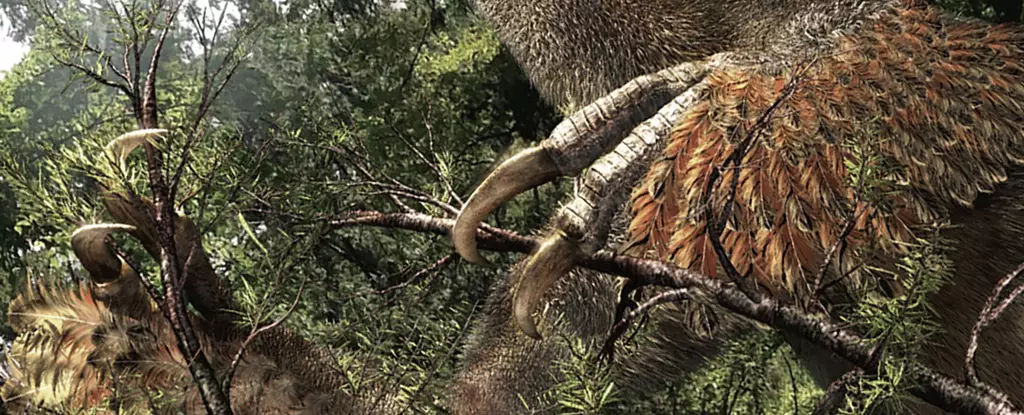In a recent breakthrough that speaks to both the intrigue of evolution and the mysteries of prehistoric life, researchers have unveiled a remarkable new species of dinosaur: Duonychus tsogtbaatari. With its two-fingered hands boasting gigantic claws, this feathered bipedal dinosaur challenges previously held notions within the theropod family. Found nestled in the limestone layers of southeastern Mongolia’s Gobi Desert, a region long known as a treasure trove for dinosaur fossils, the discovery of Duonychus is nothing short of enlightening, creating ripples of fascination and curiosity in both scientific and public spheres.
The fossil, unearthed in the Bayanshiree Formation, is not merely a fragment but a finely preserved specimen dating back approximately 90 to 95 million years. The clarity of the find amplifies its significance, detailing features that allow researchers to visualize this creature in its environment. As we peel back the layers of time, the image of this dual-clawed dinosaur takes on a vivid reality, challenging our understanding of the adaptive strategies employed by species billions of years ago.
Two Fingers, Endless Possibilities
At first glance, Duonychus presents an anomaly within the clade of therizinosaurs, which are typically characterized by their three-fingered hands. It raises an essential question in evolutionary biology: how and why does a species evolve to lose a digit? This trait, while seemingly disadvantageous at first, might hold the key to understanding the creature’s ecological niche. The impressive talons, spanning nearly 30 centimeters, hint at an adaptation for specific feeding behaviors, suggesting that Duonychus utilized a technique akin to that of modern sloths or chameleons to grasp and consume vegetation efficiently.
The evolutionary implications of its two-fingered anatomy lead us to contemplate a larger narrative regarding adaptation and survival. What advantages did Duonychus gain through this transition? Perhaps its limitations in number of fingers were overcome by specialization in feeding strategies or predation avoidance, which could redefine the role of theropods historically classified by their limb structure. The hand of Duonychus, while different, hints at a complex relationship between morphology and the environment.
Connecting to Broader Themes in Paleontological Study
What sets the discovery of Duonychus tsogtbaatari apart is not merely the physical attributes of the fossil but the broader discussions it incites. Each fossil serves as a piece in a larger puzzle of evolutionary history. As we analyze these enigmatic beings from the past, we rebound into poignant conversations about current biodiversity, ecological balance, and the very fabric of life on Earth.
Moreover, the remarkable preservation of keratin sheaths with claws—as mentioned by researchers—opens a window into the complexities of fossilization. It challenges the conventional narrative that traits such as keratin cannot withstand the test of time. This fossil propels discussions within the paleontological community to reconsider what they have long accepted about fossil preservation, thus paving the way for new research approaches and methodologies.
The Engagement of Public Fascination
The discovery’s relevance transcends the academic realm, inviting public engagement and driving enthusiasm for paleontological inquiry. Who wouldn’t be captivated by the prospect of a dinosaur with claws that would rival those of fantastical beasts? This sense of wonder is an essential element that fuels advocacy for the preservation of paleontological sites, like the Gobi Desert, which remain under threat from climate change and human activity.
In a time when environmental awareness is more critical than ever, studies like that of Duonychus remind us that the threads of life are intricately woven through time. Engaging the public with these revelations can inspire a deeper commitment to protecting our planet’s natural history, igniting a passion for both science and conservation.
As we delve into the life of Duonychus tsogtbaatari, we recognize the weight of its existence. It is a testament to the myriad forms life has taken and serves as a warning against underestimating the forces of evolution. In a world strained by ecological concerns, the legacy etched in these fossils reverberates, urging us to look toward our past to shape a sustainable future.

Leave a Reply